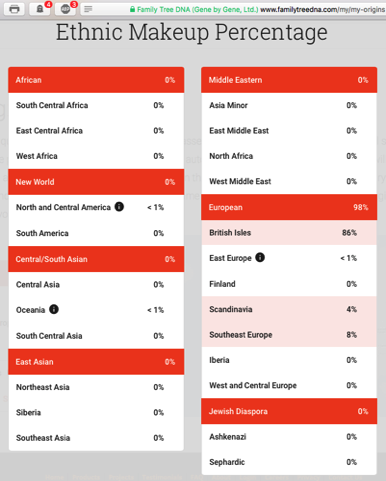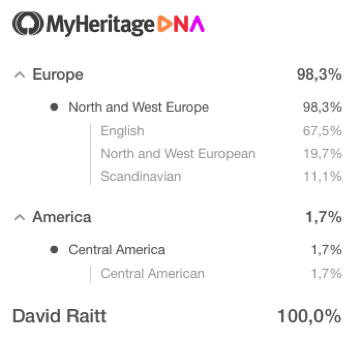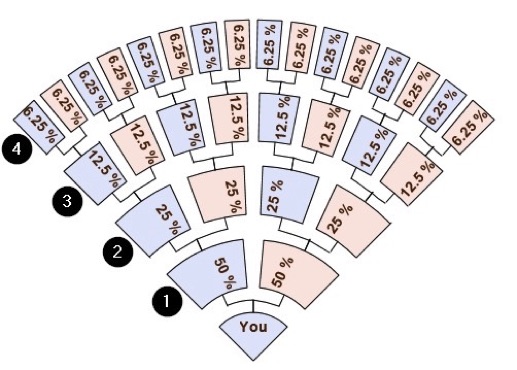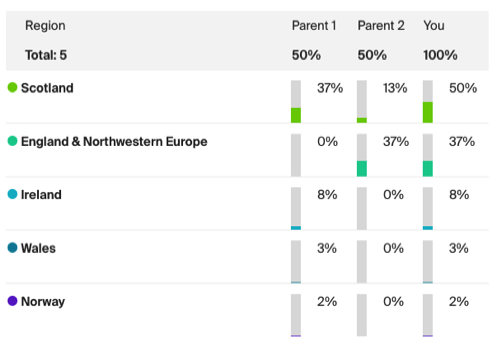My DNA from Ancestry
Well, for good measure, I also decided to have my DNA tested by Ancestry. Their emphasis, like some of the other companies, is a little different as they like to focus on showing DNA matches with other people rather than giving the Y-DNA and MtDNA haplogroups. I do have these from elsewhere, of course, but it would have been nice to have had them confirmed or better identified.
My main ethnicity estimate from Ancestry was Great Britain - 83%; and Ireland/Scotland/Wales - 12%; with West Europe and Scandinavia both on 2%. Other lower confidence estimates were less than 1% for Middle East and Caucasus. My DNA shows that I have ancestry from Great Britain, primarily located in England, Scotland, Wales in the range of 58-100%, and links me to the specific region of Scotland. My DNA also shows that I have ancestry from Ireland/Scotland and Wales in the range 0-30%, and specifically links me to Scotland. It notes that I probably had relatives who lived in Scotland in the past few hundred years. This is true!
In September 2018, Ancestry updated my ethnicity estimate - suggesting that England, Wales and Northwestern Europe account for 53% (primarily located in England, Scotland and Wales); Ireland and Scotland account for 44% with Northeastern and Central Scotland being the most specific region; and Norway accounting for 3%. All very interesting! I don't see where Wales comes in - or Norway for that matter - maybe in the dim and distant past! One thing that is noteworthy, however, is that the map showing my places, also showed Nova Scotia. Now it is true that many Scots emigrated to Nova Scotia - but I haven't found any of my family who did. So it makes you wonder - but the FAQ explains it all!
I uploaded my family tree (which does include quite a few Raitts who are not actually related to me so far as I am able to ascertain - but who are included in my Raitt Master File on my computer in order to construct trees for various families mentioned in this Raitt web site) to Ancestry (as well as several other places, such as MyHeritage, FamilyTreeDNA, Genes Reunited, and FindmyPast). I also downloaded my Ancestry raw results which I subsequently uploaded to Gedmatch, MyHeritage, and FamilyTreeDNA. Doing so has thrown up a lot of matches, such as 134 4th cousins or closer) as well as many shared ancestor hints - some of which I need to check as people have different dates to mine for some ancestors. On Gedmatch the matches are calculated from DNA raw data files submitted by users. In other sites, the matches are taken from the family tree submitted. I have given some thoughts on the various matches and degrees of kinship in a new DNA blog entry (though I don't go into the six degrees of separation theory in which any two people can be connected by a maximum of six steps!)
I also unlocked my autosomal data transfer on FamilyTreeDNA. This reveals that I have a 98% ethnic makeup from Europe, of which 86% is from the British Isles (with no further distinction - which is not very helpful), 8% from South East Europe and 4% from Scandinavia. There are trace percentages of less than 1% for Oceania, North and Central America, and East Europe. Trace percentages indicate a very small amount of shared DNA in common with the corresponding population - though it could be also attributed to background noise. It seems that from my autosomal DNA, FamilyTree estimates that I still carry a certain percentage from ancient European groups - 47% farmer, 41% hunter-gatherer, and 13% metal age invader! Actually, this ties in quite well with the trace percentages from Ancestry for the Middle East where farming originated - and also to the Caucasus and South East Europe - shades of Rhaetia?! In response to my query about no breakdown within the British Isles, FTDNA responded that "Scottish, Irish, English, etc peoples are not that genetically different from one another so we cannot accurately differentiate between these subgroups at this time. Other companies that can have so much overlap between these clusters that the percentages have way too many outliers to be considered accurate. We do not report wrong results or results that we do not have 100% confidence in."
On MyHeritage, my DNA traced back to four ethnicities: 67.5% English; 19.7% North and West European; 11.1% Scandinavian; and 1.7% Central American. It is unfortunate that they have chosen to lump in together the whole of the UK/British Isles and call it English! My ethnicity is not English, but Scottish! Other categories seemed rather broad in general - North and West Europe (nearly 20%) is just too vague! And the estimate given for Scandinavia is higher than elsewhere. I queried all this with MyHeritage and they sent me quite a detailed reply, plus a useful chart, which I quote after the other charts below.
It is interesting that both Family Tree and MyHeritage show a small percentage of Central American DNA. I wonder where they got that from! It may just be that they see there are some Raitts in Nicaragua and assume there is a relationship. Maybe the ancestor there, Oswald Raitt from Nairn, is really related to my family in the distant past! Perhaps that's also the case for Oceania - there are Raitts there - but not mine so far as I know!
It is also interesting how different companies have come up with different percentages based on the Ancestry raw data I uploaded to their sites. Ancestry gives me 95% for the whole of the British Isles, while FTDNA gives me 86%, and MyHeritage only 67.5%! Similarly, Ancestry gives me 2% Scandinavian, FTDNA gives me 4%, while MyHeritage says I have 11.1%!
In April 2022, Ancestry updated my ethnicity again and this time gave the details of what DNA each of my parents gave me (see below right). My Scottishness has gone down to 50% of which I received only 37% from my 100% Scottish father whose Scottish ancestry goes back many generations. I now have separate counts for Wales and now Ireland creeps in with 8%. I have no known Welsh or Irish ancestors and neither did my father, so far as I know, although a couple of his sisters married men with Irish roots.


As noted above, I contacted MyHeritage querying why they appeared to classify Great Britain/UK as simply English. My ethnicity estimate from them showed 67.5% English - making no mention whatsoever of Scottish. I wondered whether calling the whole of the UK and Ireland, English, was actually a misnomer? This is there reply......
"I understand that you have uploaded the raw data of a DNA test you took with a different company and you would like to know why the Ethnicity Estimate results differ between the providers.
The results you receive in the MyHeritage Ethnicity Estimate are based on an autosomal DNA test. This test analyzes DNA inherited from both your parents, giving you a range of information about where your ancestors lived before a few hundred years ago.
To estimate your ancestral ethnicity, MyHeritage compares your DNA with the DNA of people around the globe, whose genetic ethnicity is known. We call these people the Founder Populations. Currently our genetic models are based on 42 ethnic groups around the world. But this will improve thanks to our Founder Population project, the largest study of this kind ever conducted. More than 5000 participants have been handpicked to serve as references for this project by virtue of their family trees, exemplifying consistent ancestry from the same region or ethnicity for many generations. The results of these tests will yield a rich DNA data set.
Different researchers and different providers, analyzing the same DNA of a person, can come up with different estimates because the reference populations vary between every company. Therefore the results may be slightly different between the companies. Another factor is the algorithm used. Every company develops its own algorithm, which can result in a diverse ethnicity estimate.
It is also very important to know that In some regions of the world there is a unique set of genetic characteristics that are shared between the offspring of native populations. While different populations migrated from one region to another, research has shown that these sets of characteristics make some regions distinct from others, allowing us to establish a genetic model for some regions of the world.
The DNA may be very similar between people in neighboring countries. Where there isn't sufficient statistical difference, we keep the Ethnicity Estimate on a higher regional level. Even when there is a statistical difference between ethnicities, it is true for the population's average. Your DNA will always be slightly different than that of the average population, and may therefore show a small or a significant part of neighboring ethnicities.
Each person receives 50% of their DNA from their mother, and 50% from their father. The percentages of DNA a person receives from their ancestors at the level of grandparents and further back (great-grandparents, etc.) are not necessarily divided evenly in each generation.
If the percentages of DNA a person receives from their ancestors would always be divided evenly between the paternal and the maternal side, the percentages of genes inherited would look as following: 50% from the parents, 25% from the grandparents, 12.5 % from the great-grandparent, 6.25% for great-great-grandparents, and so on. The following graph shows percentages of the DNA a person receives from his ancestors up to four generations divided evenly between the paternal and the maternal side:
At seven generations back, probably less than 1% of the DNA comes from a direct ancestor.
Please note however, that the graph above is theoretical and the percentages of DNA a person receives from their ancestors at the level of second generation (grandparents) and further back are not necessarily divided evenly in each generation. It is possible that one great-grandparent may have passed on 3% of their DNA to their great-grandchild, while another great-grandparent may have passed on 11%.
This might explain some surprising results in your MyHeritage Ethnicity Estimate. Please also note that bio-geographical estimates are complicated, especially for countries in Europe. Different researchers analyzing the same DNA of a person can come up with different estimates based on a number of different factors, including the reference populations used for comparison, the algorithm, and more.
The ethnicity “North and West European” includes many countries, for example Germany, France, the Netherlands and more.
Over the last thousand years, people in (Western) Europe moved around frequently and often mixed with people from neighbouring regions. Over time, the official borders changed and so did the population. It is very difficult to find a reference population with statistical difference between ethnicities in this region and we keep the Ethnicity Estimate on a higher regional level.
Similarly, it is difficult to build a distinct profile for Great Britain and Scandinavian countries, as those are admixed with Western European DNA. Anglo-Saxon people settled the British Isles, and they were comprised of Germanic tribes. This means that their DNA is similar to the DNA of nearby regions. It is therefore possible that you have a family tree with generations of relatives that you have proof that they were born in Germany, but your Ethnicity Estimate shows British Ethnicity instead.
Determining one’s ethnicity based on DNA is a relatively new field in genetics. Great advancements have been made in the past years, but there is much more to discover. MyHeritage will continue to work on adding new ethnicities and improving the Ethnicity Estimate, based on new scientific research and discoveries."


